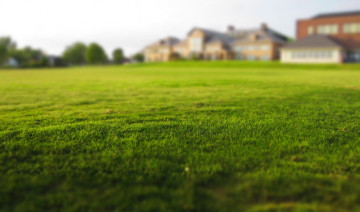
Aerate, Overseed, or Dethatch?
So what do I do with my lawn? That’s a dominant landscaping question this time of year, and we hope our thoughts that follow will help to steer you in the right direction. Lets look at 3 solutions; Dethatching, overseeding, and aerating. These are not substitutes for each other though lawns do experience some common benefits from each. An aerator puts holes into the soil by pulling out plugs to alleviate compaction which will allow air, fertilizer, and moisture deep into the soil, enhancing root development. An overseeder slices the surface of the soil approximately 1/2" deep and distributes seeds into the soil for a great way to plant new grass. Dethatchers remove surface debris, weeds, and old grass from the top of the soil that may be choking the lawn and keeping it from growing. Okay then, which one should I use?
- Use the Aerator - If you have a pretty good thick stand of desirable lawn grass already growing. Follow up with a good program of lawn seed and fertilizers. This should be done every year or 2.
- Use the Overseeder - If your lawn is spotty, with some areas of desirable grass growing but other areas of thin or no grass. If your spotty lawn is also compacted or hasn’t been attended to in a while, you might also want to use the Aerator.
- Use the Dethatcher - If your lawn has a fairly thick layer of debris on the surface. This is not a substitute for overseeding or aerating. It is normally recommended to use the dethatcher first and then the overseeder or aerator.
The Details…
Dethatcher
Simply, a dethatcher, (also called a power rake) removes thatch. Thatch is a layer of semi-decomposed grass and other organic material that accumulates above the soil faster than it can be absorbed. Thatch build-up is a normal occurrence and is not necessarily harmful to the lawn until it gets too thick. Poor mulching mower performance can be a big contributor to thatch build-up. Excess thatch forms a barrier between soil and the water, nutrients, and air required for a healthy lawn, and it may serve as a perfect breeding ground for damaging lawn diseases.
If thatch is more than ½ thick, you should consider dethatching. The easiest way to test this is to take a garden trowel, dig a small hole, and measure the organic material at the top of the soil. It should not exceed ½”. You can also use a hollow metal pipe to remove a core of soil, and measure that way. However you do it, it’s best to check several areas of your lawn since build-up can be irregular.
Aerator
Aerators will remove cores of soil from your lawn, ideally 2-3" deep. Only one pass is needed unless it’s been a few years since you’ve done it, and in that case, make 2 or 3 passes. Running over your lawn with an aerator actually serves multiple purposes. The most obvious ones are to help alleviate compaction of the soil, to allow moisture (either from rainfall or from irrigation sources) to better enter the soil, to allow fertilizers and other plant supplements such as lime to better infiltrate and mix with the soil, and to feed the grassroots at a deeper level in order to encourage stronger and deeper development of the root system.
Another purpose of aeration is to allow air to enter the soil to help carry out proper workings of bacteria that help break down organic matter on and in the soil. In this way, the grass clippings and the dead and dying grass plants or weeds and their roots will decompose and turn to humus which will actually feed the roots of the healthy lawn grasses. A sufficient amount of air is also necessary in order for the minerals in the soil to be transformed into forms that are usable by the grass plants.
Overseeder
An overseeder (or a slit-seeder as it’s sometimes called) cuts into the soil with a series of rotating blades and drops seeds into the slits it makes. It’s great for transforming a thin lawn into a lush one. These blades cut into the soil forming narrow grooves, the depth of which is determined by adjusting the machine, preferably 1/2" deep. The hardness of the soil, usually related to the moisture content, is a factor in how deeply the blades will cut. A hopper mounted on the front of the machine is filled with grass seed that is mixed into the soil at a rate that is determined and adjusted by the machine’s user. 2 crisscross passes are best using half the rate of seed for each pass.
